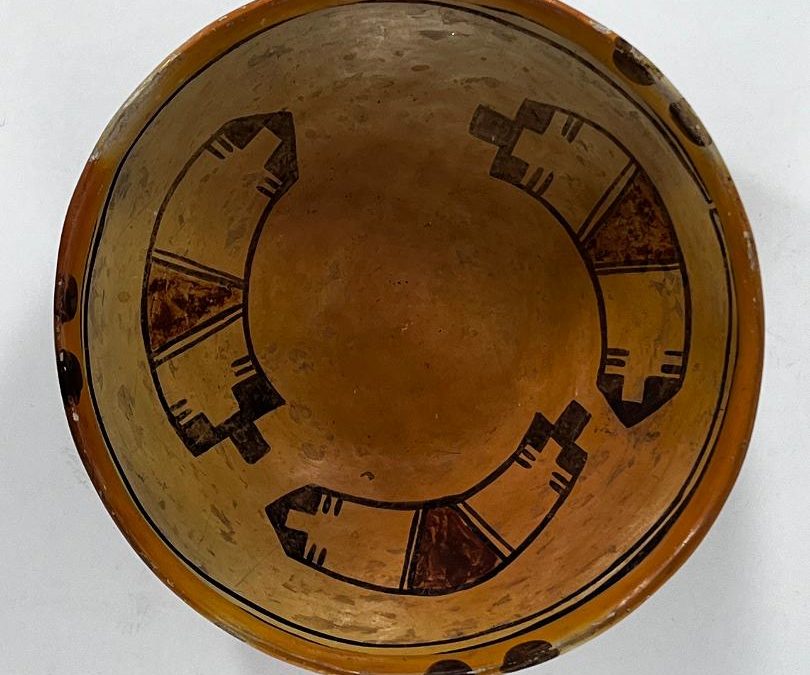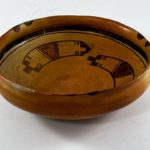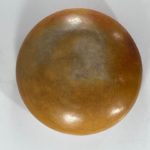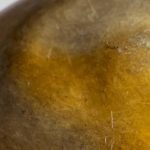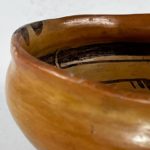This bowl is of ordinary size with a somewhat unusual everted rim. The three sets of rim ticking are indicative of a pot made during the first quarter of the 20th century. The rabbit stick design is unique.
Rabbit sticks were a common accessory of Hopi men, but I have never before seen them depicted on a pot. The design might or might not have ceremonial meaning. I have listed this bowl under “utility ware” given the possibility that it might have been made for Native use. Notice that the rabbit sticks are not equally-spaced around the interior of the bowl, but are clustered. Whether this is by error or intent will be a key issue in our discussion.
Form:
The bowl has an irregularly flat bottom, the irregularity caused mostly by an indentation (pictured above) that seems to have been accidentally created after the bowl was formed but while the clay was still wet. From this bottom the sides curve upward for about two inches, then curve inwards then outward, forming a 0.75-inch high exterior groove. On the interior of the bowl this undulation creates a dramatically-protruding ridge and a wide outwardly-sloping rim.
Design:
Painted on the interior rim of the bowl are three pairs of wide, parallel, lines: hatch marks with rounded tips. Each set is centered above the central red section of a rabbit stick, below.
Thick-above-thin framing lines encircle the bowl just below the everted rim on the interior. Both lines have spirit breaks at the same point centered on the image of a rabbit stick, below. The surface distance across the interior of the bowl between the framing lines is 6.75-inches and within this space is the design. Three identical depictions of rabbit sticks encircle the interior . These designs are not placed equidistant from each other, but are clustered together. The tip of the first is only 0.25-inches from the base of its neighbor and this second rabbit stick has a gap of 0.375-inches between itself and the third rabbit stick. However between the first and third rabbit stick there is a gap of 1.75-inches.
The tip of each stick has the form of a black triangle with an unpainted rectangle notched into its base. This unpainted rectangle is part of a large unpainted section that extends towards the midsection of the rabbit stick. Just below the base of the triangular tip, on either side of unpainted notch, are sets of two short parallel lines, “whiskers.” The far boundary of this unpainted section ends with two parallel lines, a one-lane “highway.” Following is a wedge-shaped red section, its wide edge below the framing lines and its narrow edge toward the center of the bowl. The final section of the rabbit stick is patterned like the first section but in reverse: a one lane highway followed by an unpainted expanse and sets of short parallel whiskers on either side of the final black element, an unpainted rectangle notched into its base. However, this final black element is not pointed like the first, but forms a protruding black handle used for throwing the stick at a target animal.
Design Analysis:
The design is carefully-painted. The painting on the ceremonial rabbit sticks is realistic, integrated and clear. The three renditions are consistent. Each set of hatch marks is carefully centered on a rabbit stick below, thus neither element is drawn equidistant on the bowl. Whatever meaning the design on this bowl might (or might not) have, the maker carefully linked two elements of her design.
When the source of food at Hopi was all local, people ate a largely vegetarian diet since protein sources were scarce. Few larger game animals were available, but prairie dogs and rabbits were abundant and were hunted. The weapon used was a curved “rabbit stick” that would be thrown parallel to the ground to stun the animal. Men often carried such sticks as they worked their corn fields and used them when chance encounters provided an opportunity. With one blow the stick both eliminated an an animal that might otherwise eat the corn plants and provided protein for the stew pot. Sometimes a group hunt would be organized, with the men surrounding a patch of prairie and then walking slowly towards the center, crowding rabbits into a smaller space where they would be easier targets for the rabbit sticks. For a depiction of a rabbit hunt, see jar 2024-01.
Pictured below is a well-used rabbit stick, its surface polished by frequent handling and its club head darkened, perhaps by blood.
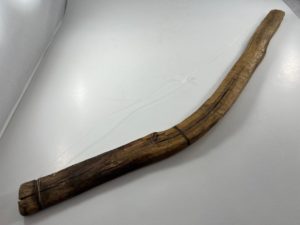
23″ tip to tip; 24.5″ curved length
Notice that the stick has a long crack that has been stabilized by three wire wraps, one at each end and one in the middle. The owner treasured this tool and sought to preserve its utility.
Each year, from about February to mid-July, kachinas return to Hopi villages and dance in the plazas. They often carry ceremonial rabbit sticks that are stubbier than the sticks made for use. Danced rabbit sticks are generally painted. Here is a ceremonial rabbit stick by Niel David, Jr., a prolific Hopi artist:
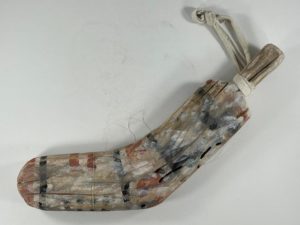
13.5″ tip-to-tip; 15″ curved length
The form of this stick is identical to the three rabbit sticks depicted on bowl 2022-08. Thus we know that the artist who made this bowl was intending to show a ceremonial rather than a utilitarian image.
Having seen a photograph of the bowl, Rachael Sahmie texted me on 8-4-22:
“I’m sure it could be for a rabbit celebration. Village went hunting for rabbit feast probably to save their corn fields. [It] could have served or blessed the rabbit hunt (as a) corn meal carrier. Makes sense. (B)eautiful bowl. Thanks for sharing. I think Hotevilla still does this hunt.”
In a subsequent phone conversation Rachael noted that the everted rim would facilitate the holding of the bowl during a dance. When holding the bowl, the thumb of each hand fits securely below the rim ridge on the interior with the first finger fitting into the external rim grove.
As a collector, it is easy to see the irregular spacing of the rabbit sticks as a flaw. I often share photographs of recently-purchased pots with Dr. Ed Wade, and I did so with bowl 2022-08. Ed generously responded in detail:
“I noticed this bowl at auction and it is quite interesting. The form of the bowl is in keeping with Nampeyo and family yet the iconography and composition is not. The realistic ethnographic depiction of three rabbit sticks is quite unusually and excellently drawn however they don’t fit well into Nampeyo’s repertory. Even when she turned to figurative imagery they were always abstracted whether mythological beings or wildlife. Also the missed alinement of the three sticks leading to a sizable negative gap between two of them would not be acceptable to her. She excelled at balanced compositions even though occasionally experimenting with asymmetry. (Email 7-25-22).”
I suggest that the large gap between the rabbit sticks is not a design flaw, but rather is intentional and key to understanding this bowl.This placement represents a Native view of a rabbit hunt: closely spaced hunters closing a gap that provides an escape route for the encircled rabbits. The bowl represents a successful hunt.
- The unusual everted rim would enable a dancer to grip the bowl firmly.
- The rabbit sticks are drawn in their ceremonial form.
- The rabbit sticks are carefully painted and rim-tic marks and rabbit stick elements are paired; the painter was careful.
- The clustering of rabbit sticks can be seen as an intentional abstract representation of hunters closing in on their prey.
Collectively these four factors support Rachael Samhie’s suggestion that bowl 2022-08 had a ritual function, perhaps carrying corn meal as an offering during a dance before a rabbit hunt. Such a conclusion remains only one possibility. What is certain is that the bowl intrigues.

